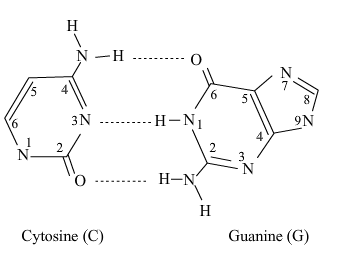
The number of hydrogen bonds between Guanine and Cytosine; and between Adenine and Thymine in DNA are:
A.${ 1,2 }$
B.${ 3,2 }$
C.${ 3,1 }$
D.${ 2,1 }$
Answer
578.4k+ views
Hint: Nucleic acids are organic atoms basic for known types of life on this planet; they incorporate DNA (deoxyribonucleic acid) and RNA (ribonucleic acid). Along with proteins, nucleic acids are the most significant organic macromolecules; each is found in abundance in every living thing, where they work in encoding, communicating, and expressing hereditary data.
Complete answer:
The guanine forms three hydrogen bonds with the cytosine because, In cytosine, the amino group acts as the hydrogen bond donor and the C-2 carbonyl and the N-3 amine as the hydrogen-bond acceptors and in Guanine the group at C-6 acts as the hydrogen bond acceptor, while the group at N-1 and the amino group at C-2 act as the hydrogen bond donors.

The adenine forms two hydrogen bonds with the thymine as the only group at N-3 and carbonyl group at C-4 in Thymine form the hydrogen bond with the amino group at C-6 and group at N-1 of the adenine.

Therefore, the number of hydrogen bonds between Guanine and Cytosine; and between Adenine and Thymine in DNA are ${ 3 }$ and ${ 2 }$ respectively.
Hence, the correct option is B.
Note: The possibility to make a mistake is that Guanine always makes a pair with Cytosine and Adenine with Thymine whereas in RNA Adenine makes a bond with Uracil, not Thymine.
Complete answer:
The guanine forms three hydrogen bonds with the cytosine because, In cytosine, the amino group acts as the hydrogen bond donor and the C-2 carbonyl and the N-3 amine as the hydrogen-bond acceptors and in Guanine the group at C-6 acts as the hydrogen bond acceptor, while the group at N-1 and the amino group at C-2 act as the hydrogen bond donors.

The adenine forms two hydrogen bonds with the thymine as the only group at N-3 and carbonyl group at C-4 in Thymine form the hydrogen bond with the amino group at C-6 and group at N-1 of the adenine.

Therefore, the number of hydrogen bonds between Guanine and Cytosine; and between Adenine and Thymine in DNA are ${ 3 }$ and ${ 2 }$ respectively.
Hence, the correct option is B.
Note: The possibility to make a mistake is that Guanine always makes a pair with Cytosine and Adenine with Thymine whereas in RNA Adenine makes a bond with Uracil, not Thymine.
Recently Updated Pages
Master Class 12 Business Studies: Engaging Questions & Answers for Success

Master Class 12 Economics: Engaging Questions & Answers for Success

Master Class 12 English: Engaging Questions & Answers for Success

Master Class 12 Maths: Engaging Questions & Answers for Success

Master Class 12 Social Science: Engaging Questions & Answers for Success

Master Class 12 Chemistry: Engaging Questions & Answers for Success

Trending doubts
What are the major means of transport Explain each class 12 social science CBSE

Which are the Top 10 Largest Countries of the World?

Draw a labelled sketch of the human eye class 12 physics CBSE

How much time does it take to bleed after eating p class 12 biology CBSE

Explain sex determination in humans with line diag class 12 biology CBSE

Differentiate between homogeneous and heterogeneous class 12 chemistry CBSE




